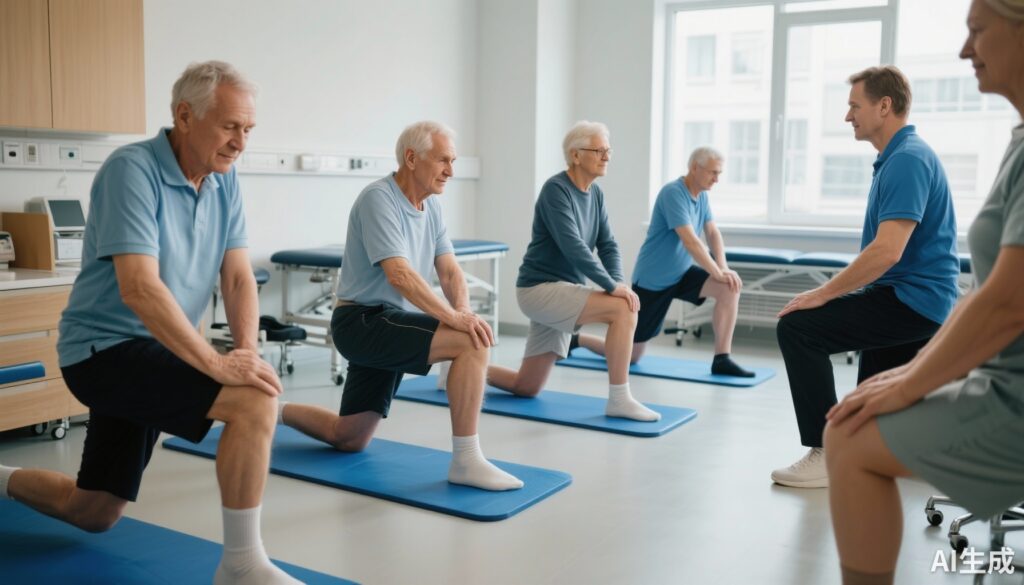Highlight
– Group physical therapy (PT) programs provide an effective and efficient treatment approach for patients with knee osteoarthritis (OA).
– This cluster randomized trial compared foundational support alone versus foundational plus enhanced implementation support (including external facilitation) for delivering group PT in VA outpatient clinics.
– Enhanced support did not significantly improve patient enrollment rates (penetration) compared to foundational support alone.
– High fidelity to therapy sessions was observed, but overall patient referral and enrollment remained modest, underscoring implementation challenges.
Study Background and Disease Burden
Knee osteoarthritis is a highly prevalent degenerative joint disease characterized by pain, decreased mobility, and reduced quality of life, especially among older adults. It constitutes a significant burden on healthcare systems worldwide due to its high prevalence and associated disability. Physical therapy is a cornerstone of conservative management for knee OA, aimed at improving joint function, reducing pain, and delaying disease progression.
Traditional one-on-one PT delivery though effective may limit access due to resource constraints and costs. Group-based physical therapy programs have been proposed as an efficient model to increase accessibility and decrease costs while maintaining clinical efficacy. Despite evidence supporting group PT effectiveness, widespread implementation of such programs remains limited, and optimal strategies for clinical program roll-out are not well established. Understanding how to facilitate the adoption and sustainment of group PT across healthcare settings is critical for addressing the unmet clinical needs of patients with knee OA.
Study Design
This cluster randomized clinical trial was conducted from January 31, 2022, to March 18, 2024, involving 19 outpatient physical therapy departments within the Department of Veterans Affairs (VA) Healthcare system. These sites agreed to implement a structured group PT program targeting symptomatic knee OA patients.
Sites were randomized into two implementation arms:
1. Foundations Support Arm: This included dissemination of self-guided implementation tools and monthly collaborative calls to support group PT delivery.
2. Enhanced Support Arm: In addition to foundational support, it provided tailored external facilitation for sites underperforming based on predefined benchmarks at 6 and 9 months.
The intervention involved delivery of six group PT sessions over 12 months, integrating both exercise and educational content tailored for knee OA management.
Primary implementation outcomes were measured during months 7 to 12 post-implementation and included:
– Penetration: Mean number of patients enrolled per month at each site (primary outcome).
– Fidelity: Mean number of classes attended per patient, reflecting adherence to therapy.
Generalized linear models were used to compare outcomes between implementation arms.
Key Findings
The 19 sites (10 in enhanced support and 9 in foundational support) delivered group PT to a total of 144 patients (68 enhanced support, 76 foundational support) during months 7 to 12. The majority of patients were male (90.3%) with a mean age of 67 years.
– Penetration:
– Enhanced support arm: Mean enrollment was 1.0 patients per month (95% CI, 0.2-1.7).
– Foundational support arm: Mean enrollment was 1.0 patients per month (95% CI, 0.1-1.9).
– The mean difference in penetration between arms was -0.1 (95% CI, -1.1 to 1.0), which was not statistically significant (P = .92).
– Fidelity:
– Enhanced support arm: Patients attended a mean of 5.0 out of 6 classes (95% CI, 4.3-5.7).
– Foundational support arm: Patients attended a mean of 4.1 classes (95% CI, 3.2-4.9).
– The difference in fidelity favored enhanced support by 0.9 classes per patient but did not reach statistical significance (95% CI, 0.0-1.9; P = .06).
These findings indicate that while enhanced support may potentially improve therapy adherence, it did not translate into increased patient enrollment. Overall, the rate of patient referral and uptake was modest, highlighting the persistent challenge of integrating group PT into routine clinical practice.
Expert Commentary
The study appropriately leveraged a pragmatic cluster randomized design, enhancing the generalizability of its findings within large healthcare systems such as the VA. The use of multiple cohorts and clearly defined implementation support strategies provides rigorous insight into clinical program adoption.
Limitations include the predominantly male veteran population, which may limit extrapolation to broader community settings. Additionally, the modest patient enrollment across sites suggests barriers beyond implementation support, such as clinician referral behaviors, patient preferences, or system-level constraints, which were not fully addressed.
This trial underscores the complexity of translating evidence-based group PT programs into standard practice. External facilitation, while valuable for tailored support, may not be sufficient without parallel strategies addressing referral pathways and stakeholder engagement.
Conclusion
The cluster randomized trial demonstrated that enhanced implementation support, including individual external facilitation, did not significantly outperform foundational support in increasing patient enrollment for group physical therapy in knee osteoarthritis. Fidelity to therapy sessions was moderately higher with enhanced support but was not statistically significant.
The modest penetration rates reflect ongoing challenges in fostering referrals and integrating new clinical programs. Future research should explore multi-faceted strategies combining implementation support with targeted interventions addressing referral workflows, provider incentives, and patient engagement.
Overall, group-based physical therapy remains a promising modality for knee osteoarthritis management. Optimizing its implementation in clinical settings requires a nuanced understanding of organizational and behavioral factors that influence adoption and sustainment.
References
1. Allen KD, Webb S, Coffman CJ, Anderson L, Cummin G, Drake C, Tucker M, Webster A, Sperber N, Zullig LL, Hughes JM, Ballengee LA, Abbate LM, Hoenig H, Fullenkamp N, Van Houtven CH, Hastings SN. Implementation of Group Physical Therapy for Knee Osteoarthritis: A Cluster Randomized Clinical Trial. JAMA Netw Open. 2025 Oct 1;8(10):e2535038. doi: 10.1001/jamanetworkopen.2025.35038. PMID: 41037266; PMCID: PMC12492051.
2. Bannuru RR, Osani MC, Vaysbrot EE, Arden NK, Bennell K, Bierma-Zeinstra SM, et al. OARSI guidelines for the non-surgical management of knee, hip, and polyarticular osteoarthritis. Osteoarthritis Cartilage. 2019 Nov;27(11):1578–89.
3. Goh SL, Persson MSM, Stocks J, Hou Y, Lin J, Hall MC, et al. Relative efficacy of different exercise types for the treatment of knee and hip osteoarthritis: a systematic review and network meta-analysis. Sports Med. 2019 Nov;49(12):1679–92.
4. Duda JL. Implementing physical activity interventions in health care settings: barriers, facilitators, and strategies. J Sport Health Sci. 2020 Jul;9(4):295–7.



